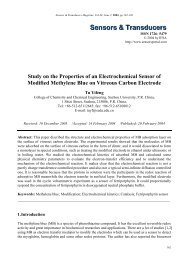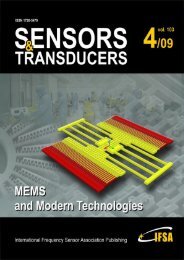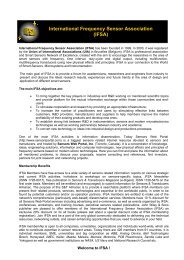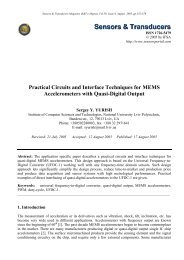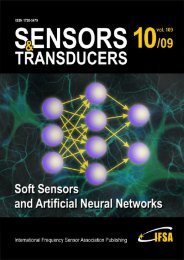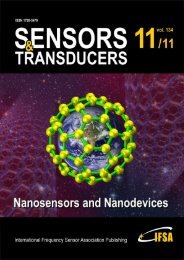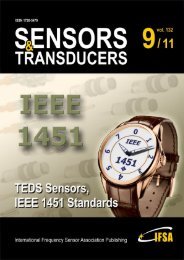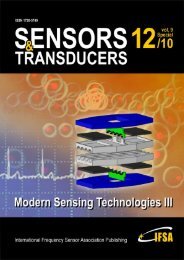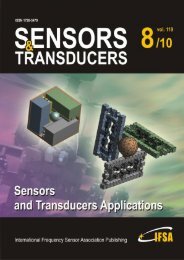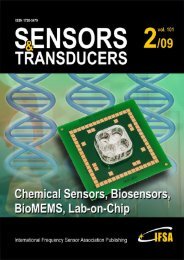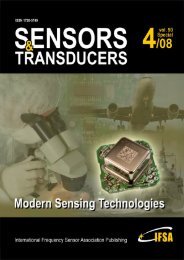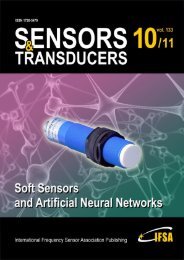Recent Advances in DNA Biosensor - International Frequency ...
Recent Advances in DNA Biosensor - International Frequency ...
Recent Advances in DNA Biosensor - International Frequency ...
Create successful ePaper yourself
Turn your PDF publications into a flip-book with our unique Google optimized e-Paper software.
Sensors & Transducers Journal, Vol. 92, Issue 5, May 2008, pp. 122-133<br />
7. <strong>DNA</strong> Biochip<br />
Microarrays, <strong>DNA</strong> arrays, gene chips or biochips are same term<strong>in</strong>ology often be<strong>in</strong>g <strong>in</strong>termixed to<br />
describe analysis of complex <strong>DNA</strong> samples and expression of genes [59, 60, 77, 78, 79, 80]. The most<br />
attractive features of these devices are the m<strong>in</strong>iaturization, speed and accuracy. Accord<strong>in</strong>gly, this <strong>DNA</strong><br />
microchip technology offers an enormous potential for rapid multiplex analysis of nucleic acid<br />
samples, <strong>in</strong>clud<strong>in</strong>g the diagnosis of genetic diseases, detection of <strong>in</strong>fectious agents, measurements of<br />
differential gene expression, drug screen<strong>in</strong>g or forensic analysis. Such use of <strong>DNA</strong> microarrays is thus<br />
revolutioniz<strong>in</strong>g many aspects of genetic analysis.<br />
The biochips are fabricated from glass, silicon or plastic supports, and comprise thousands of<br />
10-100 µm reaction zones onto which <strong>in</strong>dividual oligonucleotides have been deposited. This results <strong>in</strong><br />
high densities (up to 10 6 sites/cm 2 ) <strong>in</strong> connection with typical 1-2 cm 2 -size chips. The exact number of<br />
probes varies <strong>in</strong> accordance with the application. The actual construction of gene chips <strong>in</strong>volves the<br />
immobilization or synthesis of an array of <strong>DNA</strong> probes on a solid support. High-density <strong>DNA</strong> arrays<br />
often require the use of physical delivery (e.g. microjet deposition technology), <strong>in</strong>volv<strong>in</strong>g the<br />
dispension of picoliter volumes onto discrete locations on the chip. It is essential to activate the surface<br />
for a covalent attachment of the oligonucleotide probes.<br />
Successful implementation of <strong>DNA</strong> chip technology requires development of methods for fabricat<strong>in</strong>g<br />
the probe arrays, detect<strong>in</strong>g the target hybridization, algorithms for analyz<strong>in</strong>g the data, and<br />
reconstruct<strong>in</strong>g the target sequence. Such array technology thus <strong>in</strong>tegrates molecular biology, advanced<br />
microfabrication / micromach<strong>in</strong><strong>in</strong>g technologies, surface chemistry, analytical chemistry, software,<br />
robotics and automation. The automation of gene chip systems greatly facilitates their production and<br />
accelerates their operation, while elim<strong>in</strong>at<strong>in</strong>g human errors. The detection of the <strong>DNA</strong> hybridization<br />
(at the <strong>in</strong>dividual spots) relies on the signal generated by the b<strong>in</strong>d<strong>in</strong>g event. The most common<br />
application of <strong>DNA</strong>/oligonucleotide microarray is gene expression analysis. In this technique, RNA<br />
isolated from two samples are labeled with two different fluorochromes (generally the green cyan<strong>in</strong>e 3<br />
and the red cyan<strong>in</strong>e 5 (Cy3, Cy5)) before be<strong>in</strong>g hybridised to a microarray consist<strong>in</strong>g of large numbers<br />
of c<strong>DNA</strong>s / oligonucleotides orderly arranged onto a glass microscope slide. After hybridization under<br />
str<strong>in</strong>gent conditions, a scanner records, after excitation of the two fluorochromes at given wavelengths,<br />
the <strong>in</strong>tensity of the fluorescence emission signals that is proportional to transcript levels <strong>in</strong> the<br />
biological samples. The microarray data are analyzed us<strong>in</strong>g specific software that enables cluster<strong>in</strong>g of<br />
genes with similar expression patterns, assum<strong>in</strong>g that they share common biological functions.<br />
8. Conclusions and Future Prospects<br />
From the first discovery of electrochemistry of nucleic acids by Palecek at the end of the 1950’s [81],<br />
huge progress can be observed, particularly at the development of electrochemical <strong>DNA</strong> biosensors<br />
based on the nucleic acid as biorecognition element. Different types of electrodes immobilized with<br />
specific probes can be used to detect the presence of complementary target sequence by hybridization<br />
technique. Besides the different immobilization methods, electroactive hybridization <strong>in</strong>dicators (metal<br />
complexes, daunomyc<strong>in</strong>, methylene blue, etc.) and different conduct<strong>in</strong>g polymer based nanocomposites<br />
are also used for development of electrochemical biosensors.<br />
SPR, Quantum-Dot and piezoelectric biosensors are the emerg<strong>in</strong>g area of molecular diagnosis. The<br />
Intelligent Opto sensors <strong>in</strong>terfac<strong>in</strong>g based on universal frequency-to-digital converter has opened new<br />
opportunities for development of <strong>DNA</strong> biosensors [82]. Some success has been achieved <strong>in</strong> the<br />
commercialization of optical fiber sensors. However, they still suffer from competition with other<br />
mature sensor technologies and new ideas are be<strong>in</strong>g cont<strong>in</strong>uously developed and tested not only for the<br />
traditional measurands but also for new applications [83-84].<br />
129



